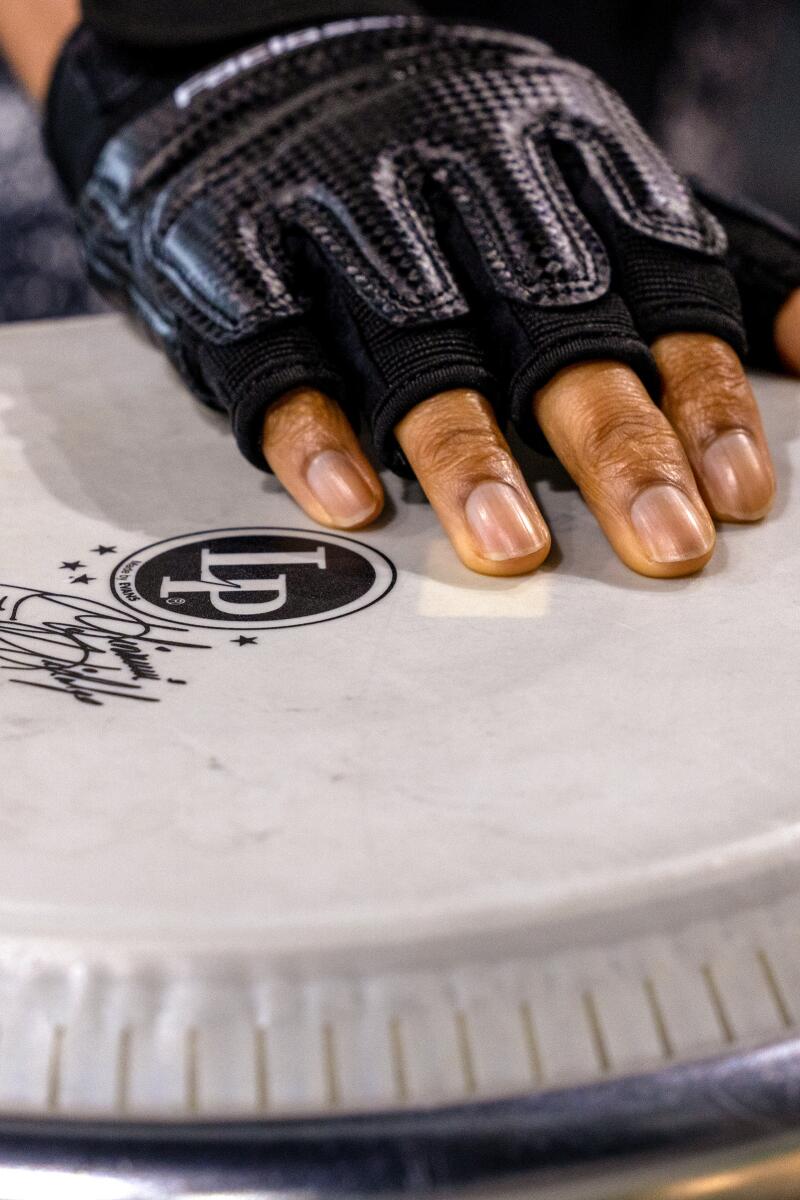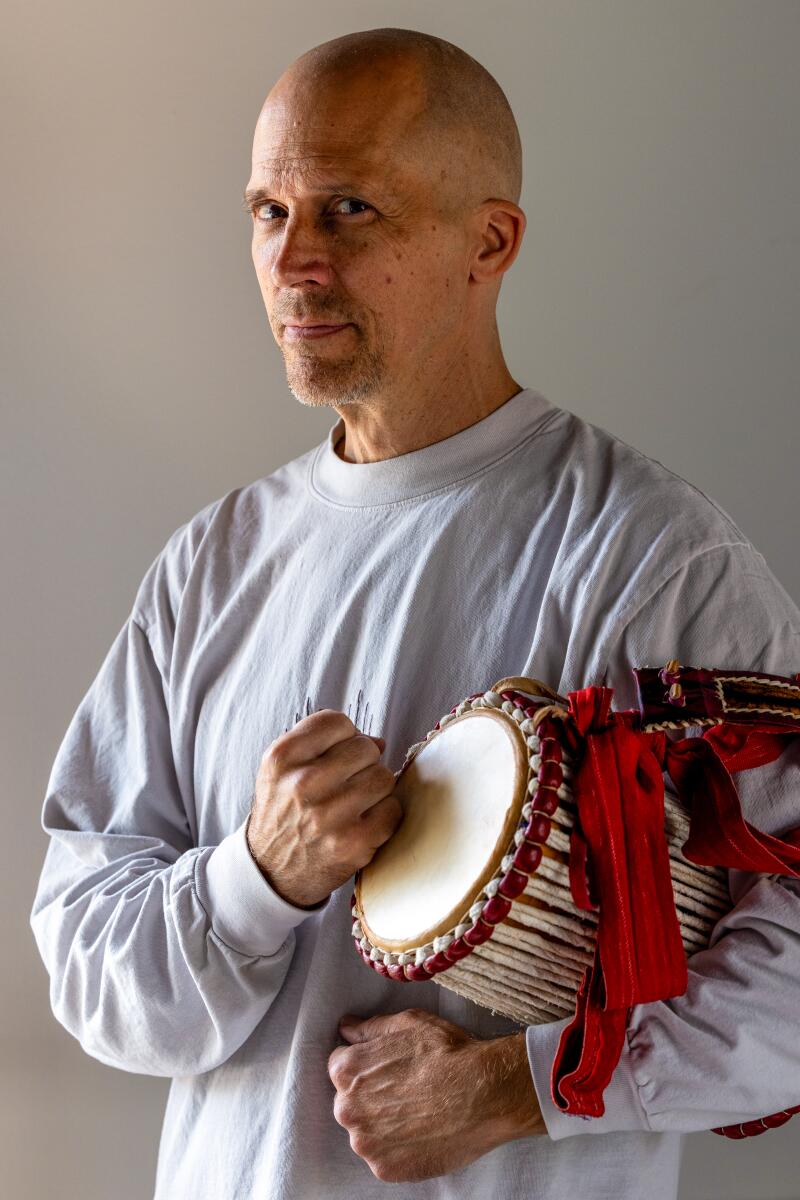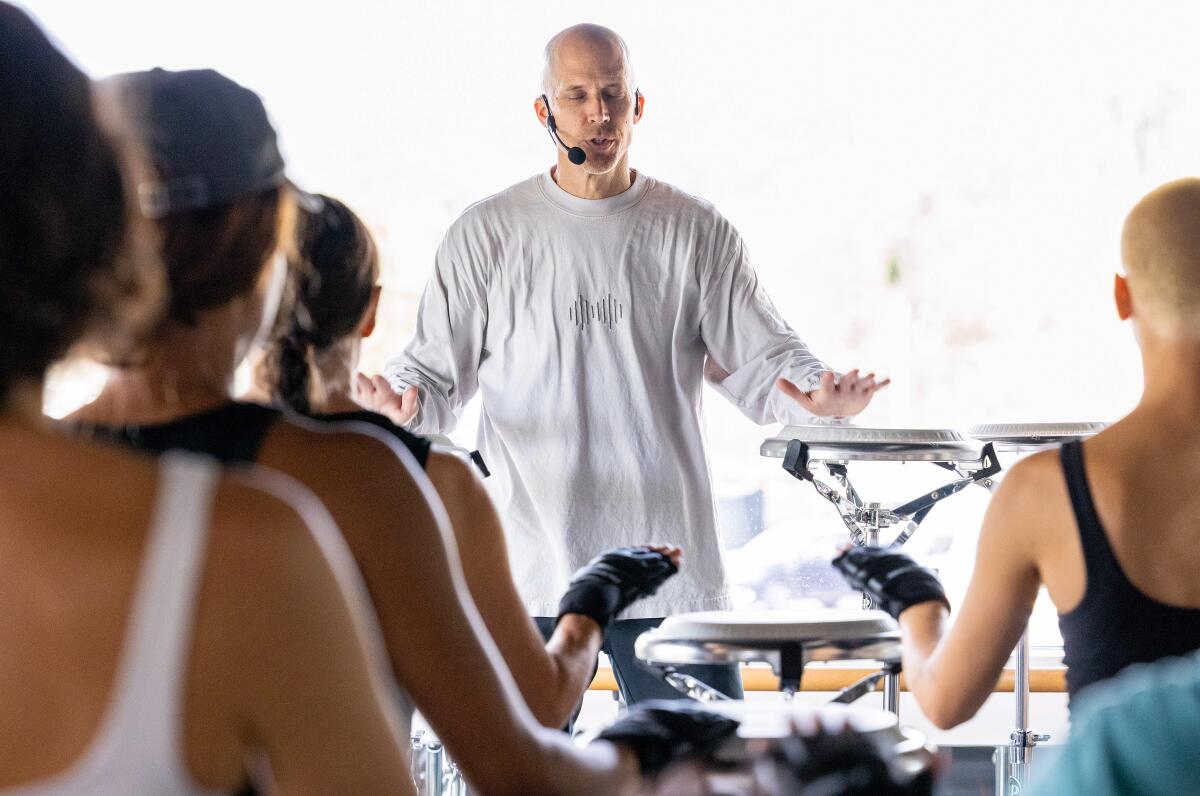Drumboxing is a ‘gym for the brain.’ Would you try it?

It’s an early Wednesday morning, and I’m about to work out — my noggin.
I’m at a “gym for the brain” in Malibu, readying for a group fitness class. It features a targeted aerobic exercise, performed to music, meant to develop focus, resilience and adaptability — all while torching calories.
The class is called Drumboxing, a new, so-called “brain fitness” technique developed by John Wakefield, a percussionist who plays with the Los Angeles Opera. He composed music, incorporating Latin and Afro-Cuban rhythms, that he combined with physical boxing moves and intricate, Simon Says-like patterns. The workout is meant to challenge your brain by switching up rhythm, tempo, meter and movement in an ever-fluid environment.

Drumboxers wear thin, mixed martial arts gloves for the exercise. (Brian van der Brug / Los Angeles Times)

Drumboxing co-founder John Wakefield is a Los Angeles Opera percussionist. (Brian van der Brug / Los Angeles Times)
Wakefield has been teaching the technique, privately, to boxers and other athletes for more than a decade. He and his business partner, former pro beach volleyball player Christina Hinds, opened a studio for Drumboxing earlier this year and it’s caught on among locals, including several celebrities. Cindy Crawford and LeAnn Rimes are regulars; Gabby Reece has taken the class as well. So have moms, tech and entertainment executives, nearby Pepperdine University students and scores of others.
“People talk about elevating their heart rates in the class — some wear Apple watches — and it checks that box,” Wakefield says of Drumboxing. “But almost always, the first comment is: ‘Oh, I didn’t think about anything else while I took this class — the emails I had to answer or what meetings I had to go to — I was able to focus and be present.’ People like the brain engagement.”
The Drumboxing studio is nondescript, a former Pure Barre space in Malibu Country Mart that’s flooded with sunlight this morning. But the setup is novel: There’s a grid of custom, free-standing conga drums, on adjustable-height steel frames, in the center of the room and a line of heavy bags, like boxers use, against a wall of mirrors. About a dozen of us wear lightweight mixed martial arts gloves to protect our hands and wrists.
We each claim a space among four standing drum heads, which we’ll pivot between doing shallow jumps and rhythmic twists while banging on the different drums. Wakefield gives us a short tutorial: “Focus on the rhythm. It’s all about the rhythm,” he says. Then, as the music starts up, he begins to hit his drum, slowly at first, creating numerical patterns we’re meant to follow with our hands and feet.

John Wakefield, right, leads a Drumboxing class, combining Afro-Cuban rhythms, boxing moves and a Simon Says-like game.
(Brian van der Brug / Los Angeles Times)
“1-2-1-1!” he yells, playing his conga heads. We take a wide stance, stepping side to side and banging in sync.
At first it’s easy and there’s a sense of camaraderie as we swivel and stamp collectively. But as Wakefield mixes up the patterns — calling out “Alt!” when we’re meant to pair opposite hands and feet or, later, asking us to follow the cues he gives us with his hands and not the conflicting cues he sends verbally — we inevitably fall out of sync. The scene devolves into what looks like a giant, three-dimensional Rubik’s Cube, with individuals at the center of each quadrant spinning, messily, in different directions — all peppered with a healthy dose of laughter.
Our mistakes, however, are exactly the point of the exercise. Drumboxing is designed to induce mistakes, “to push you to a border of achievement and failure, floating back and forth,” Wakefield says. “And it’s about getting past those mistakes and learning to move forward rather than be perfect.”
The adaptability skill that Drumboxing hones can be applied in the real world, Wakefield says.
“You’re working on it in a fun, nonthreatening, game-like environment,” he says, “but you can take that skill — how to read and react to your environment when it’s not completely in your control, or even when it’s chaotic — into different environments.”
Drumboxer Vajra Kingsley, 33, says she was dyslexic as a child and workouts incorporating right-left coordination were difficult for her. “But Drumboxing, it’s not about getting it right,” she says. “It’s about understanding how your mind is reacting when you get something wrong. You come out of the class with a sort of physical and mental confidence.”

Drumboxing is meant to induce mistakes in a fun, nonthreatening environment, so that class members hone their adaptability skills.
(Brian van der Brug / Los Angeles Times)
All exercise stimulates the brain because it gets the blood flowing and releases endorphins that improve mood and focus, among other things. Drumboxing is different, Wakefield says, because “it’s an exercise meant to target the brain first and foremost, as its sole purpose and by design.” Aerobics and dance are similar to Drumboxing in that they incorporate coordinated movements to music; but the movements are meant to be learned, refined and then repeated over time. Drumboxing, by comparison, “is always changing — that’s the point,” Wakefield says.
Wakefield and Hinds are not scientists. But they’ve been interviewing neuroscientists at USC for about five years to better understand the effects of music and exercise on the brain.
Neuroscientist and USC professor Glenn Fox has served as one of their advisors, though he has no equity or financial investment in their company. He says there are no studies on Drumboxing yet because it’s so new. But the technique, he says, “shows tremendous promise for attention, mindfulness and presence.”
“My hypothesis,” Fox says, “is that Drumboxing engages a greater demand on working memory than other exercises — it’s like Simon Says meets improvisational music meets dance meets drumming meets boxing — and that’s where it provides extra brain stimulation. Also, there’s a lot of research on the importance of having fun for brain development.”
Wakefield, 56, says he didn’t set out to invent an exercise — it happened organically. He’s a trained musician first, who grew up outside of Washington, D.C., and he studied music at the University of Maryland and, for graduate school, USC. Basketball — not boxing — was the sport he played for fun.
In 2010 he took his then-11-year-old son, Calvin, to a boxing gym in Canoga Park to try something new. Given his musical background, the gym owner asked Wakefield to work with one of his fighters who was talented but “needed to loosen up, find some rhythm.” Wakefield had the fighter, Anatoliy Dudchenko, mimic him on the congas and noticed how, when he switched up the rhythms, Dudchenko focused harder and for increasingly longer periods. Soon he was training multiple fighters at the gym, with conga heads placed in plastic Home Depot buckets stacked to adjust for height. He mixed in boxing moves with the music.
Wakefield noticed that the fighters he was working with experienced similar effects. “Their focus, especially under pressure, increased,” he says, “and I noticed they’d get better at dealing with whatever came towards them. Not letting it throw their concentration or game plan.”
His sister-in-law, Pam Claytor, then a first grade teacher in Howard County, Md., asked him to make a video for her students as a “brain break” during class; it was so successful that other elementary schools in the area began using it. Because the students didn’t have drums to use, or a percussionist to perform live for them in class, Wakefield instead wrote music that he combined with the boxing-like movements, and that’s how Drumboxing came into being.

Drumboxing co-founder Christina Hinds was blown away when she first saw the new exercise technique.
(Brian van der Brug / Los Angeles Times)
Meanwhile, 40-year-old Hinds, who grew up between Beverly Hills and Malibu, was at the intersection of sports and science. She studied psychology at Pepperdine University and played professional beach volleyball for the Greek national team from 2007 to 2012 (her dad is Greek). As part of her subsequent wellness and personal training business — along with a documentary she was then producing about “second acts” in life — she was interviewing neuroscientists at USC, including Fox, who were studying the effects of purpose on performance.
“I was interested in flow state,” Hinds says. “Flow state is when you’re completely present and nothing else matters — that’s when you have peak performance. Drumboxing absolutely puts you in flow state.”
It was Fox who introduced Wakefield and Hinds in 2019 because of their mutual interests.
Wakefield performed a Drumboxing demo in Hinds’ Point Dume driveway, with his then-18-year-old daughter, Morgan, demonstrating the technique.
“It blew my mind,” Hinds says.
They decided to take Drumboxing to the masses, holding pop-up classes in people’s homes at first. “I thought: This is not just for athletes. It’s for entrepreneurs, it’s for creatives, it’s for moms with busy lives and seniors. This is for everybody,” Hinds says, adding that Drumboxing can be performed as a low-impact or high-impact exercise.
“My goal is to be able to pick up my granddaughter for as long as she wants me to,” says Maria Moyer, a 58-year-old artist who takes Drumboxing regularly. “I know I’m getting a good cardio workout because I keep track of my heart rate. But for somebody who spent most of her life feeling like the most coordinated person, often I’m totally backwards from everyone else — and it makes me laugh. It feels like play.”
The long-term plan for Drumboxing is to make it a “brain hub,” Hinds says, where visitors can take EEGs of their brains before and after classes and attend workshops led by neuroscientists and others.
The exclusivity of Drumboxing is a concern. The Malibu class costs $45 for a 55-minute session (or $200 for a package of five).

Drumboxing, which Wakefield says hones focus and resilience, includes a wind-down session that could be considered what he terms “meditation in motion.”
(Brian van der Brug / Los Angeles Times)
Wakefield and Hinds acknowledge that the price is steep but say that’s because they’re just getting started. The Malibu studio, launched with funds from lead investors Peter and Sandra Lowy, is meant to be a flagship space. They’re developing a series of nomadic pop-ups, to take classes around Los Angeles for a fraction of the cost. They’re also developing an online platform on which students can buy drum sets and livestream classes or take archived classes. There will also be drumless online classes, incorporating sync-alt patterns using hands and feet, as well as lower-impact, seated versions of classes.
“We want to make sure people can do this outside of Malibu,” Hinds says. “We’re also starting a teacher training course. With more instructors, we’ll be able to be in more places at once, and that’ll bring down the cost a lot.”
After class, Wakefield adds that — for all its focus on the brain, a kind of “meditation in motion” — Drumboxing shouldn’t be discounted as a cardio exercise that’s also good for agility training.
A low-impact workout might burn 200 to 400 calories, he says, and a high-impact version, about 600 to 800 calories.
At which point Hinds jumps in: “But we count brainwaves more than we count calories!”




